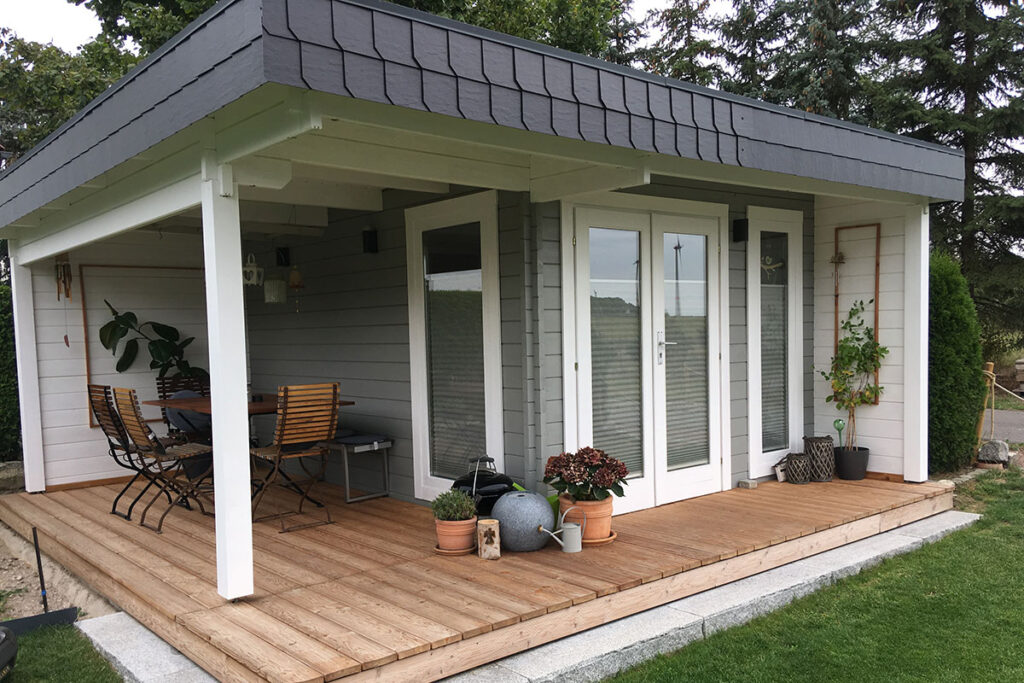
Stuck on choosing colors for your garden room? You’re not alone. The options can be overwhelming! This guide will walk you through everything from practical considerations to creative color combinations—all with real-life examples from CasetasdeJaring24 customers to spark your imagination.
Before grabbing paint swatches, ask yourself these questions:
1. How sunny is your shed’s location? Dark colors fade faster in direct sunlight and trap heat inside—not ideal for hot summer days.
2. What’s your garden room’s purpose? A home office benefits from focus-enhancing blues and greens. Creative studios pop with stimulating colors. Need a relaxation space? Go for soft, natural tones with colorful accessories for personality. Entertainment areas? Be bold!
3. What’s the architectural style? Traditional wooden garden rooms shine with natural stains in various opacities. Modern designs? Think contemporary grays, blacks, and minimalist colors.
4. What colors dominate your garden year-round? Consider seasonal changes, existing landscaping, and hardscape elements like pavers and fences. Planning landscape changes? Perfect timing to create your dream color palette for the entire garden.
5. Visibility matters. Where will you see your garden room from? The main house? Neighbor’s property? Garden seating areas?
6. Complement or contrast? Should your shed match your home or stand out?
7. What mood are you after? Calm and serene calls for soft blues, greens, or neutrals. Cozy and warm? Try earthy tones or warm whites. Fun and cheerful? Bright colors or pastels. Modern and minimalist? Go monochromatic or create stark contrasts.
8. How much maintenance can you handle? Light colors show dirt but fade less. Dark colors hide dirt but need more frequent repainting. Natural stains typically need refreshing every 2-5 years.
9. What’s your personal style? Timeless classics? Trendy options you’ll update periodically? Bold colors that scream “you”?
10. Think long-term. Is this a quick fix or a lasting color scheme? Selling soon? Choose colors that enhance your property’s overall appeal.
11. Budget considerations. Some colors require multiple coats or frequent touch-ups. Invest in quality brands. CasetasdeJardin24 always offers high-quality brands like Remmers HK.
Useful tip: Always test your samples under different lighting conditions. Colors can transform dramatically throughout the day. Also keep in mind that colors appear more intense on large surfaces than on tiny swatches.
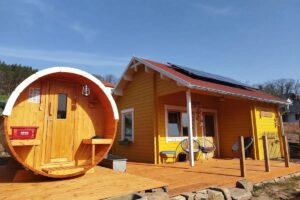
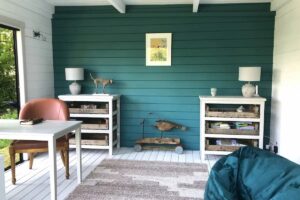
Paint creates an opaque layer that completely hides wood grain. Perfect for specific colors or covering imperfections. Most exterior wood paints work as a system:
Paint Pros:
Paint Cons:
Stain is translucent and showcases wood grain. it’s ideal for styles with beautiful wood or natural aesthetics. Available in varying transparencies, with some solid stains offering more thorough coverage, thus resembling paint more.
Keep in mind that many wood treatments are designed as systems, like paint. Applying just one component leaves your shed vulnerable to leaks and warping.
Important note for spruce garden rooms: Never use clear stain alone—UV rays can cause ugly dark spots. Cedar and larch, however, gray evenly and can handle clear top coats.
Stain Pros:
Stain Cons:
Warm Tones create cozy, inviting spaces – perfect for Spanish gardens. These colors shine during colder months, brightening gray days with welcome warmth.
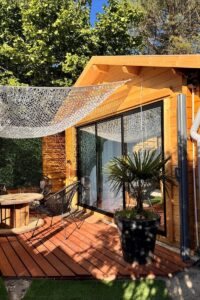
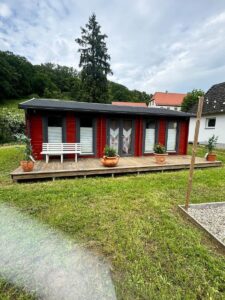
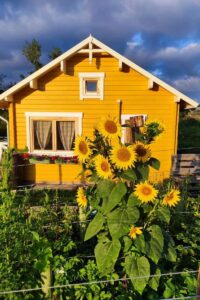
Popular Warm Options:
Warm Tone Advantages:
Warm Tone Drawbacks:
Cool Tones offer calm, contemporary vibes that make gardens feel spacious and serene.
Popular Cool Options:
Cool Tone Advantages:
Cool Tone Drawbacks:
Neutral Tones offer timeless elegance and versatility—a safe, sophisticated choice for any garden.
Popular Neutral Options:
Understanding color relationships creates stunning, thoughtful shed designs. For exteriors, consider cool grays with blue or green undertones, or warm wood tones like yellows, oranges, and reds. Rather than using multiple colors on the structure itself, try one main color with complementary trim.
Classic Complementary Colors (opposite on the color wheel) create vibrant, high-contrast combinations:
Analogous Colors (neighbors on the color wheel) create harmonious, cohesive looks:
Monochromatic Schemes use variations of a single color for sophisticated cohesion:
These schemes are popular for good reason—they look stunning with minimal effort!
Pro Tip: Follow the 60-30-10 rule: 60% dominant color (walls), 30% secondary color (details), and 10% accent color (doors or decorative elements).
Choosing your garden room colors should be fun and rewarding! When ordering from CasetasdeJaridn24, you can purchase wood protection and stain systems directly from us. We offer a wide selection of colors – perfect for making your shed unique and authentically yours!